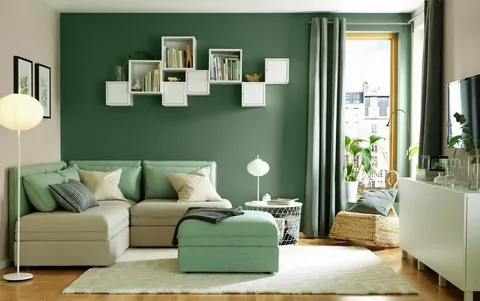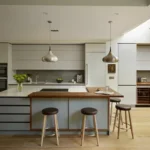Minimalism Doesn’t Have to Mean Boring- Minimalism is all about simplicity, clean lines, and a clutter-free environment. But what if you want to infuse some color into your minimalist space without compromising its essence?
In this article, we’ll explore five tips for mixing in color as a minimalist, striking the perfect balance between simplicity and vibrancy. Let’s embark on this journey to discover how to bring life and energy to your minimalist haven.
RELATED: Choosing Paint Colors for Your Home: Create A Mood with Color Psychology
Tips for Mixing in Color as a Minimalist
Understanding Minimalism and Color
Before we delve into the tips, it’s essential to grasp the core principles of minimalism. Minimalist design emphasizes functionality, simplicity, and a “less is more” philosophy. It’s about creating an environment where every element serves a purpose and there’s no room for unnecessary clutter.
On the other hand, color has a profound impact on our emotions and the overall atmosphere of a space. Each hue carries its own set of emotions and can dramatically alter the mood of a room. Therefore, it’s crucial to harmonize the two—minimalism and color—to create a space that is visually appealing and emotionally satisfying.
Balancing Neutrals and Color
One of the fundamental aspects of minimalist design is the use of neutral colors such as white, black, gray, and beige. These hues provide a clean, timeless backdrop for your space. When introducing color, it’s essential to maintain a balance between these neutrals and your chosen hues. Think of neutral colors as the canvas, and your selected colors as the brushstrokes.
Consider using colorful elements sparingly to maintain simplicity. For instance, you can add colorful throw pillows, blankets, or decorative vases to a predominantly neutral living room. The key is to create a focal point with color without overwhelming the space. By doing so, you maintain the elegance and tranquility of a minimalist design.
Using Color as an Accent
Color accents are your best friend when it comes to mixing color with minimalism. They are like the exclamation points in your design statement. Colorful accents can breathe life into your space without dominating it. For instance, a set of vibrant dining chairs can add a touch of playfulness to an otherwise neutral dining room.
Consider using color accents in your decor, such as colorful cushions, artwork, or decorative bowls. The key is to use these accents sparingly to draw attention to specific areas of your space. This approach not only adds personality but also creates a dynamic visual experience in your minimalist environment.
Creating Harmony with Color
Choosing the right colors that work well together is essential to maintaining a harmonious atmosphere in your minimalist space. When selecting colors, think about the overall mood you want to create. Warm colors like reds and yellows can bring energy, while cool colors like blues and greens evoke calmness.
Additionally, you can explore color schemes, such as complementary or analogous, to create a balanced and visually pleasing combination. Analogous colors are next to each other on the color wheel and often create a soothing effect, while complementary colors, found opposite each other on the wheel, provide a dynamic contrast.
Colorful Furniture and Accessories
To add a burst of color to your minimalist space, consider investing in colorful furniture and accessories. A colorful sofa or a vibrant coffee table can be the focal point of your living room while maintaining the simplicity of the design.
When incorporating colorful furniture, make sure it aligns with the overall color scheme of the room. It’s essential to ensure that the furniture complements the existing neutral elements and doesn’t create visual chaos. Selecting furniture with clean lines and a minimalist design aesthetic can further enhance the cohesiveness of your space.
Art and Wall Décor
Art can be a powerful tool in introducing color to your minimalist design. A colorful artwork or an abstract painting can serve as a captivating focal point in your room. The key is to choose art that resonates with your color scheme and complements the space’s ambiance.
If you’re concerned about overwhelming your minimalist walls with color, consider a single, large piece of artwork that makes a bold statement without cluttering the room. Art can not only add vibrancy but also a sense of individuality and culture to your space.
Plants and Natural Elements
Nature’s greenery can be an excellent source of color for your minimalist space. Houseplants, with their lush green leaves and colorful flowers, can introduce a fresh and vibrant dimension to your design.
Plants not only add color but also a sense of tranquility and vitality. They can serve as a connecting element between the indoors and outdoors, creating a serene environment that’s harmonious with the principles of minimalism.
Lighting and Color
Lighting plays a crucial role in the perception of color in your space. The right lighting can enhance the vibrancy of your chosen colors. For example, warm lighting can make reds and yellows appear even more vivid, while cool lighting can enhance the serenity of blues and greens.
Consider experimenting with various lighting options, such as pendant lights, floor lamps, or wall sconces, to create different moods in your space. Dimmable lighting can provide flexibility, allowing you to adjust the intensity and warmth of the light to suit your desired atmosphere.
Personalizing Your Space
One of the beauties of minimalism is that it provides a canvas for you to express your personality and preferences. By incorporating your favorite colors and personal touches, you can create a space that reflects your unique style.
Whether it’s through artwork, decorative objects, or even a colorful accent wall, personalization brings warmth and authenticity to your minimalist design. Make your space a reflection of your taste, and it will undoubtedly be more beautiful and meaningful.
The Psychology of Color
Understanding the psychology of color is key to making informed decisions about color in your minimalist space. Each color carries its own set of emotions and connotations. For instance, blue is often associated with calm and serenity, while red evokes energy and passion.
Consider the mood you want to create in each room of your home. For a peaceful bedroom, opt for cool and soothing colors. In a home office, choose colors that stimulate creativity and focus. By leveraging the psychological effects of color, you can tailor your space to serve your specific needs.
Overcoming Common Challenges
Mixing color and minimalism can present challenges, such as maintaining simplicity while adding vibrancy. Some common pitfalls include over decorating, using too many colors, or failing to create visual balance.
To overcome these challenges, start with a clear vision of your color palette and stick to it. Be mindful of not overloading your space with color, and use neutrals as your foundation. Regularly edit and declutter to maintain the clean lines and simplicity of minimalism.
RELATED: The 10 Best Colors to Paint Your Living Room
Case Studies in Colorful Minimalism
To inspire your journey into colorful minimalism, let’s explore a few real-life examples of beautifully designed spaces. These case studies showcase how designers have successfully incorporated color while staying true to minimalist principles. Each case study offers valuable insights and ideas for your own home.
Example 1: A Tranquil Bedroom Retreat
In this case study, we explore a minimalist bedroom that exudes tranquility and relaxation. The primary color scheme is a combination of soft blues and muted grays. The use of a monochromatic palette creates a serene atmosphere, perfect for rest and rejuvenation. The minimalistic approach is maintained through simple furniture and clean lines.
Example 2: A Vibrant Living Room
Our second case study focuses on a vibrant and colorful living room. This space uses bold, primary colors in moderation to create a visually striking environment. Red and yellow accents are paired with a neutral backdrop to provide a cheerful and energetic ambiance. The minimalist aspect is preserved through functional furniture and an uncluttered layout.
Example3: A Green and Natural Kitchen
The third case study takes us to a kitchen that celebrates the beauty of greenery. Houseplants and natural elements, such as wooden countertops and open shelving, infuse color and life into the space. The green color palette creates a harmonious connection with the outdoors while maintaining the simplicity of minimalist design.
These case studies demonstrate that a minimalist space can be both beautifully colorful and functional. By carefully selecting colors, maintaining a sense of balance, and personalizing the space, you can achieve stunning results in your own home.
Final Thoughts
Minimalism Doesn’t Have to Mean Boring- In conclusion, mixing color with minimalism is not only possible but can lead to stunning results. By understanding the principles of minimalism, balancing neutrals and color, using color as accents, creating harmony, and incorporating colorful furniture, art, plants, and lighting, you can infuse vibrancy into your space while preserving its simplicity.
Additionally, considering the psychological effects of color and addressing common challenges will help you navigate the path to a beautifully colorful minimalist environment.
And remember, your personal touch and the art of harmonizing colors are your greatest allies in achieving a space that is both visually appealing and true to your unique style.
Now that you’re equipped with these tips, it’s time to embark on your journey of colorful minimalism. Enjoy creating a space that is not only visually beautiful but also emotionally satisfying and uniquely yours.
FAQs (Frequently Asked Questions)
- Is it possible to have a minimalist home with color?
- Absolutely! You can maintain minimalist principles while incorporating color by carefully selecting colors, using them as accents, and maintaining a sense of balance in your design.
- How can I choose the right colors for my minimalist space?
- Start by considering the mood you want to create in each room. Select colors that align with that mood, and use color psychology as a guide. Remember to maintain a cohesive color scheme.
- Can I personalize my minimalist space with color without overwhelming it?
- Personalization is key to making your space beautiful and unique. Use color to express your personality through decor, artwork, and accent pieces while keeping a minimalist foundation.
- What are some common challenges in mixing color with minimalism, and how can I overcome them?
- Common challenges include over decorating, using too many colors, and failing to create visual balance. To overcome these challenges, start with a clear vision of your color palette, be mindful of overloading your space with color, and regularly edit and declutter.
- Are there specific color schemes that work best for minimalism?
- Minimalism can work with a variety of color schemes. It’s essential to maintain simplicity and balance, but the specific colors you choose should align with the mood and purpose of the room.




